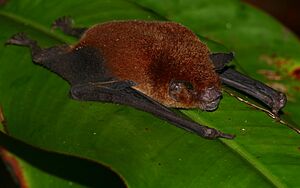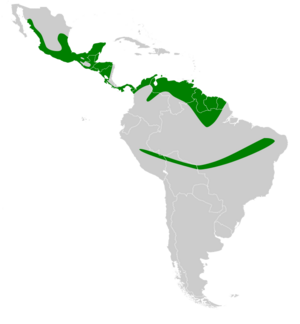Wagner's mustached bat facts for kids
Quick facts for kids Wagner's mustached bat |
|
|---|---|
 |
|
| Conservation status | |
| Scientific classification | |
| Genus: |
Pteronotus
|
| Species: |
personatus
|
| Subspecies | |
|
P. p. personatus |
|
 |
|
The Wagner's mustached bat (Pteronotus personatus) is a type of bat that lives in South and Central America. These bats are known for a special skill called Doppler shift compensation. This helps them navigate and find their way around, especially when flying fast.
About Wagner's Mustached Bat
Wagner's mustached bat is a small bat. Its body is about 6 to 6.7 centimetres (2.4 to 2.6 in) long, and its tail is about 1.5 to 1.8 centimetres (0.59 to 0.71 in) long.
These bats can have two different fur colors. Some are dark brownish-black with gray undersides. Others are more clay-brown or reddish-yellow with lighter, buff-colored undersides. You can find bats of both colors living together in the same cave.
Their ears are long and pointy. They have jagged edges and a special flap called a tragus inside. The bat's upper lip has many stiff hairs and surrounds its nose. The snout, which is the nose area, points upwards.
The skin that forms their wings reaches down to their ankles. They also have a large membrane, called a uropatagium, between their legs and tail. The short tail sticks out from the middle of this membrane. Their wings are long and thin. This shape usually means a bat can fly very fast. However, because Wagner's mustached bat is so small, it doesn't fly as quickly as other bats with similar wings. They usually fly between 10 and 19.6 km/h (6.2 and 12.2 mph).
Reproduction
Female Wagner's mustached bats have babies once a year. They usually give birth to one young bat. This happens around the start of the rainy season, which is in June or July.
Where They Live
Wagner's mustached bats live in tropical areas. You can find them in Mexico, as far north as Sonora and Tamaulipas. They also live in central and western Central America. In South America, they are found along the southern coast of the Gulf of Mexico, reaching east to Suriname. They also live in a strip from the Pacific coast of Colombia through eastern Ecuador, central Peru, northern Bolivia, and across central Brazil.
These bats prefer to live in forests. This can be anything from very wet rainforests to drier deciduous forests (where trees lose their leaves). They live at elevations up to 1,000 metres (3,300 ft) high. They often hunt for insects along rivers, streams, or dry riverbeds called arroyos. They like to travel along local canyons.
There are two main types, or subspecies, of Wagner's mustached bat:
- Pteronotus personatus personatus – This type lives in South America, Panama, Costa Rica, Nicaragua, and eastern Honduras.
- Pteronotus personatus psilotis – This type lives in western Honduras, El Salvador, Guatemala, Belize, and Mexico.
Scientists have found fossils of Wagner's mustached bats on the island of Tobago. These fossils are from a long time ago, during the late Pleistocene era. This suggests that these bats might have lived in more places in the past than they do today.
How They Behave
During the day, Wagner's mustached bats rest in hot, humid caves. Their groups, called colonies, usually have from 100 to 10,000 bats. Some colonies are even larger! They like caves that stay at a steady temperature, usually between 30 and 36 °C (86 and 97 °F). If the temperature drops below 20 °C (68 °F), they can start to get too cold, a condition called hypothermia.
These bats often share their roosts with many other types of bats. Sometimes, Wagner's mustached bats are only a small part of all the bats in a cave.
Wagner's mustached bats use echolocation to find their way around and hunt. This means they send out high-pitched sounds, called ultrasonic pulses. These sounds bounce off objects and come back as echoes. The bats listen to these echoes to create a picture of their surroundings.
They are one of the few bat species that use a special trick called Doppler Shift Compensation. When a bat flies, the sound waves it sends out can change frequency as they bounce back, due to something called the Doppler effect. Wagner's mustached bat can change the frequency of the sounds it sends out to make up for this change. This helps them navigate easily, even when flying quickly through thick forest trees and leaves.


